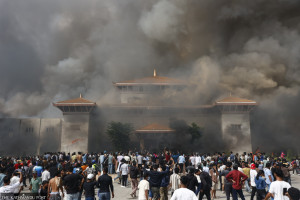Kathmandu
200 monkeys in Thapathali are in trouble. They neither have home nor food
The High Powered Committee for Integrated Development of the Bagmati Civilization says it’s not aware of the monkeys, ward chair wants to cage the free-roaming animal.jpg&w=900&height=601)
Anup Ojha
Over 200 monkeys living along the banks of the Bagmati in Kalmochan Ghat, Thapathali, are in trouble. Their habitat has been degraded, and they don’t get enough to eat.
While a project worth over Rs 1 billion “beautifies” the area, some officials say they are not aware of the habitat of monkeys; others want to cage them to stop them from troubling people.
“The Prasutigriha area in Thapathali and the Bagmati river corridor used to be full of trees, but they are all cut now,” said zoologist Mukesh Chalise, who has done extensive research on rhesus macaque (the monkeys found in Thapathali). “It’s the people who snatched their natural habitats from them.”
People who have seen the monkeys roam the area freely in the past are concerned that the primates’ man-made habitats are also under threat. “As the trees here are already gone, the monkeys used to live in old satals (travellers’ rest houses) and the Shivalaya (Shiva temple),” said 40-year-old Ram Swarup Das Visnab, the main priest at Ram Mandir in Kalmochan, who was born and raised in the area. “Even the satals are being demolished for reconstruction now, but nobody is concerned about the issue.”
“What if the Ram Mandir here has no monkeys, the incarnation of Hanuman (the monkey god)?” asks Visnab as the High Powered Committee for Integrated Development of the Bagmati Civilisation prepares to renovate or reconstruct 26 monuments, including satals and temples on the three-kilometre stretch from Kal Mochan Ghat to Teku Dovan (confluence).
“We are going to renovate or reconstruct 26 monuments in the area, but nobody informed us regarding the monkeys’ habitat. We were only concerned about managing humans and their habitat,” said Yogendra Chitrakar, senior division engineer of the committee that plans to spend Rs1.15 billion it received from the Asian Development Bank to “beautify” the area.
A food shortage has also affected the monkeys, said Ramananda Giri, 59, the head priest of Synashi Aakhada who has been living in Kalmochan for nearly two decades. “Unlike Swayambhu and Pashupatinath, the other two habitats of monkeys in Kathmandu, the Kalmochan area does not get visitors and pilgrims who would feed the monkeys,” said Giri. “I remember that until a few months back, a woman used to come here regularly to feed the monkeys, but she too has stopped coming.”
Due to disturbances in their habitats and lack of food in Kal Mochan ghat, the monkeys have started coming out and are getting more aggressive, locals say. “They used to come here frequently until a few months ago, but they now come here regularly, snatch biscuits, or whatever they can and run,” said Vidayarthi Jaiswal, who runs a grocery shop in Thapathali.
“More than that, these monkeys are troubling pedestrians. People can’t walk on this road section carrying food items. In many instances, they have even snatched mobile phones and handbags from women” he said.
When the Post contacted Ward No. 11 Chairperson Hiralal Tandukar to inquire what the ward office had done to save the monkeys, he said he was about to cage the monkeys.
“I don’t see any other way out of the situation. They are troubling people,” said Tandukar. He said the ward plans to build a “monkey zoo” in the area, where people can pay to see them. The money would then be used to feed the monkeys, he added.
But priests and sages who have been living in Kalmochan for decades term Tandukar’s announcement as “cruel and insensitive”.
“Who would pay to see monkeys?” asked Giri. “These monkeys have been living here for years and they haven’t done any harm to people. If they are given enough food, and their habitat is preserved, they won’t trouble people.”
Giri said he was concerned that the monkeys were ailing.
“But I have never seen a vet visit this place for their treatment. These monkeys may be living with diseases,” he said. Zoologist Chalise says monkeys in Kathmandu, in general, suffer from asthma, respiratory problems, and gastrointestinal disease. “If these monkeys move and they start living near human settlements, they can spread viruses, which could be fatal. But luckily, they haven’t been diagnosed with viral ailments in Nepal so far.”
“The government body is running a project of billions of rupees. Do these animals have the right to live or not? This is the crucial question,” the zoologist concludes.




 16.12°C Kathmandu
16.12°C Kathmandu.jpg)











